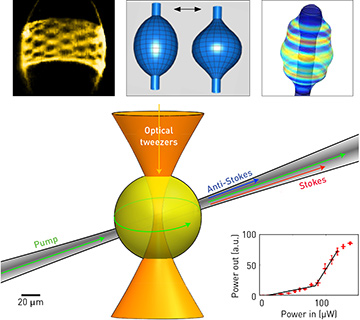 Top (left to right): Optical, capillary and acoustic resonances of droplet microcavities. Bottom: Experimental setup for a water-wave laser in which light is coupled to a tweezed microdroplet via a tapered fiber. When pump frequency is tuned to one of the droplet resonances, coherent capillary oscillations accompanied by Stokes emission appear above a 77 μW threshold (inset). [Bottom figure reprinted by permission from Macmillan Publishers Ltd., Nat. Photon. 10, 758, ©2017]
Top (left to right): Optical, capillary and acoustic resonances of droplet microcavities. Bottom: Experimental setup for a water-wave laser in which light is coupled to a tweezed microdroplet via a tapered fiber. When pump frequency is tuned to one of the droplet resonances, coherent capillary oscillations accompanied by Stokes emission appear above a 77 μW threshold (inset). [Bottom figure reprinted by permission from Macmillan Publishers Ltd., Nat. Photon. 10, 758, ©2017]
Water waves, known scientifically as capillary waves, are familiar to everyone. This year, our team experimentally demonstrated stimulated amplification of light mediated by capillary waves.1
Our experimental setup is based on our recent demonstration of continuously pumped microdroplet resonators,2 which allowed us to map the droplet’s optical,3 capillary4 and acoustic5 resonances (top of figure). Two key enablers facilitate our optocapillary energy exchange: We leveraged the droplet optical finesse to over a million, and we transformed the capillary oscillations from the overdamped to the underdamped regime.4
As with stimulated Brillouin scattering and stimulated Raman scattering, the increase of input power (at 770 nm) led to coherent optocapillary oscillations. The intensity of the Stokes line, originating from capillary wave, as a function of the input power exhibits a knee shape (inset in figure). This knee, at 77 μW, marks the region where the optocapillary gain turns larger than loss (including via viscosity) and is referred to as the threshold-power of this water-wave laser.
Optical interrogation4 and then excitation1 of capillary waves takes optofluidics to a regime in which a very important wave in fluids, the water wave, can exchange energy with light. This contrasts with microfluidic devices, in which solid walls typically prohibit optocapillary interactions. Our optocapillary cavity is a million times softer than what is available with the current, solid-based technology. Such softness accordingly enhances optically induced deformation, which can benefit optical cooling of capillary waves. Such a dramatic improvement in cooling might, in the future, take capillary waves toward their quantum ground state.
Researchers
Shai Maayani, Leopoldo L. Martin, Samuel Kaminski, Sarah T. Attar, Raphael Dahan and Tal Carmon, Technion–Israel Institute of Technology, Haifa, Israel
References
1. S. Kaminski et al. Nat. Photon. 10, 758 (2016).
2. S. Kaminski et al. Opt. Express 23, 28914, (2015).
3. S. T. Attar et al. Opt. Express 24, 13134 (2016).
4. S. Maayani et al. Nat. Commun. 7, 10435 (2016).
5. R. Dahan et al. Optica 3, 175 (2016).
